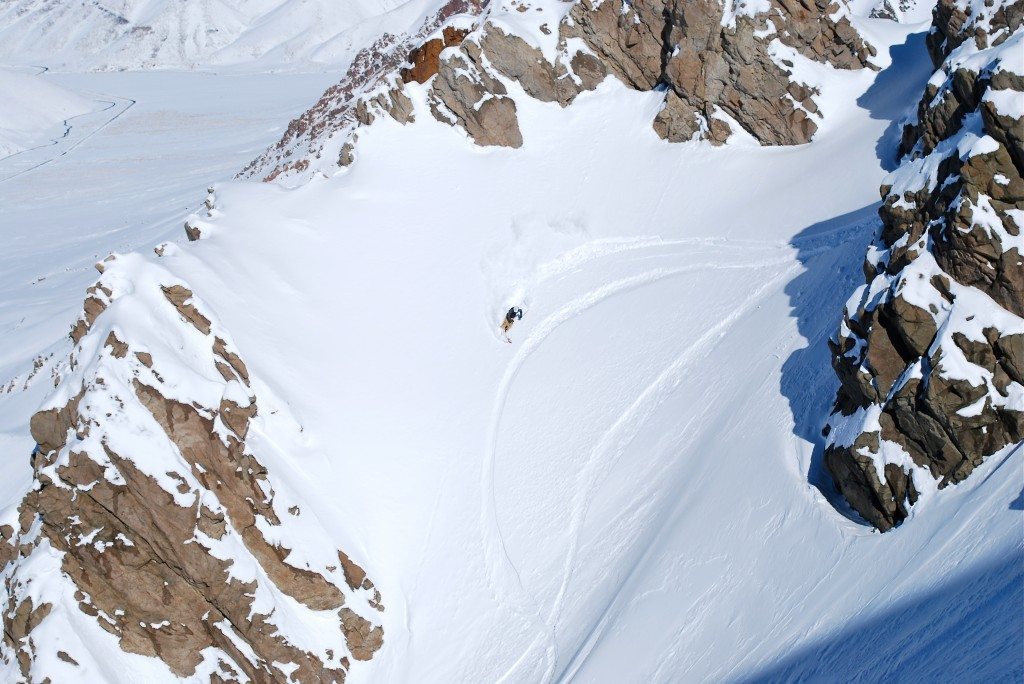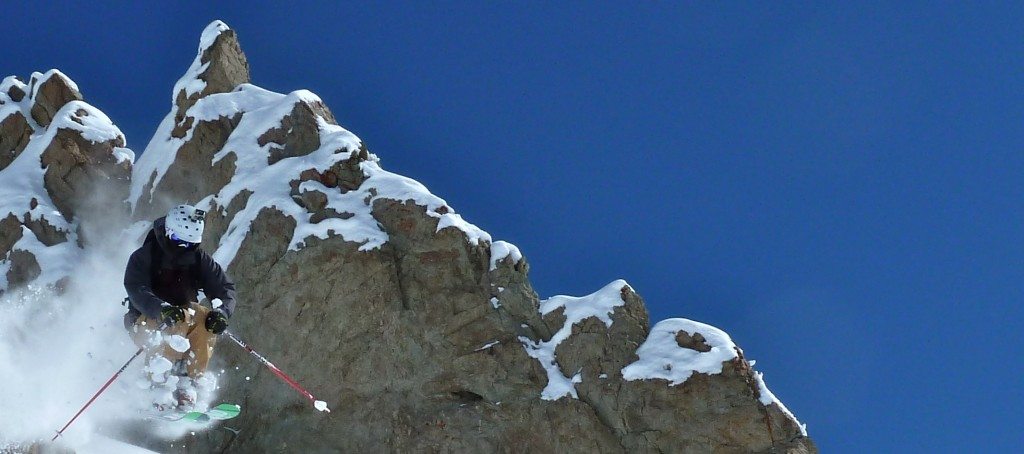Ski: ON3P Caylor, 191cm
Dimensions (mm): 148-120-140
Boots / Bindings: Salomon Falcon Pro CS / Marker Jester (DIN at 9)
Mount Location: -5cm from true center
Test Location: Las Leñas
Days Skied: 3
My first day out on the Caylor coincided with the first of a beastly four day storm to hit Las Leñas. Known to move in during mid to late August, the famous “Santa Rosa” dropped around 5 feet of snow at the top of the Marte lift. On Wednesday and Thursday we were skiing right in the middle of the storm cycle in whiteout conditions. I have to say, it was some of the worst visibility I’ve ever skied in. But with the 1 ½’ of fresh already on the ground and flakes coming down hard, no one cared, and after a few runs I put the comfort of sight aside and trusted the Caylor.
I started out with the skis mounted at -3 from core center (ON3P’s recommended mount point) and assumed a neutral stance, making moderately wide turns straight down the fall line of Cenidor. Skiing a big, near center-mounted pow ski can be difficult when you’re unable to anticipate dense patches of untracked snow or the deep troughs in between. When I tried to open things up on Cenidor, I continually found myself getting thrown forward onto the shovels and back onto the tails, unable to maintain the most stable stance on the skis. For Santa Rosa storm skiing, moving the bindings back 2cm (-5 from center) gave them a really nice balance of charging ability and a willingness to pivot. I thought once the storm cleared and things went blue, I might move the Caylors forward again, but given my riding style and the wide open lines Las Leñas offers, I never felt the need to.
Those first two days of blind testing really forced me to tune in to the way this ski reacts when laid over to high edge angles in untracked snow and heavy chop. The Caylors only have 8mm of taper from tip to tail which seems like the perfect amount for a ski of this type. I didn’t experience any bothersome hooking from the tips when shutting down speed in chop. For most of those first two days on the Caylors, I couldn’t see what I was about to ski through, but I knew they could handle it. Storm riding on the Caylors? Check.
Friday brought completely calm, bluebird skies. We rolled up to the base of the Marte lift just as it began to spin, the whole line cheering as each chair was loaded. GoPros were rolling and the stoke was high.
For our first run on our first true LL pow day, we cruised over to the entrance to La Pantalla, a huge apron with dense wind affected chop at the top that turned into lighter untracked pow toward the runout. I dropped right in making deliberate but sizable turns down the fall line. The Caylors handle chop extremely well, and better than I had expected. They may have a healthy amount of reverse camber, but are stiff and damp, without any weird “butter zones,” so they don’t behave like some other fat, rockered noodles out there.

While I haven’t ski last year’s model of the Caylor, this year’s (with a mellower, more gradual rise to the tip and tail), seems to have a dialed flex profile. Motoring through the snow in the entrance to Pantalla, and blasting over heavier crud under the Caris chair, the Caylors stayed calm and collected. Even with the slightly rearward mount point, they still have a very symmetrical, balanced feel when thrown sideways.
With what relatively little time I’ve ridden the Caylors on groomers, I can confidently say that they’re not an energetic ski. They remain composed on hardpack, but turns are slow to engage, lumbering, and long. I can’t see myself riding the Caylor as an everyday ski. In bumps or tight trees, you may find yourself working harder than the rest of the crew. Personally, for firm days in between storms in Colorado, I’d prefer a narrower, generally lighter, more nimble ski to go jib around on. If you’re looking for a ski that’s bomber and machs through crud, but is also playful and fun on groomers, the Caylor may not be it.
However, if you’re primary objective is to destroy any soft snow or chop in sight – and terrify small furry animals along the way – keep reading. For charging over variable snow, off drops, and through chop, the same stiff and heavy construction that makes the Caylor less than exciting on groomers allows them to stay stable and quiet with no tip deflection or chatter. It’s a tradeoff that I’m totally willing to accept.

The Caylor had proven itself to be an exceptional ski to charge on in less than fresh conditions. Luckily for us, Santa Rosa had dropped quite a bit of fresh on Las Leñas’ open terrain, so there was no shortage of untouched fields to lay tracks down that morning.
These skis don’t have much traditional camber underfoot, only 1mm. At first, I doubted it would be all that noticeable in their performance, and in terms of pop or a fierce bite on hardpack, I can’t say I noticed much. Additionally, that slight bit of camber didn’t make the skis reluctant to slarve of surf. Rather, paired with nearly symmetrical dimensions, what little arc the Caylor has seems to aid in stabilizing the ski during fast, wide turns through pow—especially keeping the outside ski in check against any unpredictable wobble—and simply helps the skis track on hardpack. The result: flying through rock pinnacles in Eduardo Variante, the smooth shovel of La Pala, and down the massive apron in lower Tercera, the Caylor’s performed flawlessly. Given their weight, they do take some encouragement to slarve at higher speeds. But once you’re laid out through the turn, stability is solid and dependable
In shorter turns in steeper terrain, or in low angle pow, the Caylor won’t do anything horribly unexpected. Make a clear, strong, and aggressive move, and they will deliver.
ON3P is offering a lighter version of the 181 and 191 Caylor, with a thinner core and lighter composite layup. I’m not a heavy dude at 155 lbs., but the standard issue Caylor was manageable, so long as I kept my skiing strong. If you’re a lighter person, or generally prefer a lighter ski, I’m confident that you’ll still terrorize woodland animals on the Caylor Lite. If this tweaked version shares the same stiffness and some degree of dampening qualities as the regular Caylor, I don’t doubt it will still be an awesome ski for big days.
Bottom line: if you like a ski with a healthy amount of tip and tail rocker (but hate dealing with chatter in chop), and are done with hyper-surfy reverse camber boards that seem to have a mind of their own in anything but immaculate pow, the Caylor might just be the ski you’re looking for.
NEXT PAGE: ROCKER PROFILE PICS


Hey there Will,
Solid review for sure! I am looking to you for some advice here. I have skied the original 186 Bibby pros for the past three seasons and lllllloved them. There were some things that I would like to have seen improved, and pretty much I think the 190 addresses them. But the Caylor intrigues me as well. Can you give me a comparison of the two? Any thoughts, ideas, suggestions would be greatly appreciated!
Thanks in advance.
Cheers!
Hi Remre,
I have to admit I have not skied the 190 Bibby Pro, yet (we have a pair in house that I will get on soon). However, I can confidently make some general comparisons between the Caylor and the 184cm Bibby, which has the same flex profile as the 190. The most noticeable difference is their feel on hardpack and dampening qualities. The Bibby Pro has a lighter, more poppy feel than the Caylor on groomers. This makes a good deal of sense, considering the Bibby has 4mm more camber underfoot and is built with a pine/aspen wood core reinforced with carbon stringers. The Caylor on the other hand is built with a bamboo/triax fiberglass core layup, which feels a little damper and heavier through chop, but isn’t quite as lively as the Bibby on harder snow. They’re both awesome skis. Choosing between the two will be determined largely by your own skiing style, and the kind of terrain you typically ride.
Hope this helps,
WB
Hey so I’m looking for a powder jib ski similar to skis such as the Benchetler or the Moment Night Train. I’m a little bigger than you (175 lbs, 6 ft) and have a racing background as well as a competitive park background (nothing serious, just small comps). Did you get the chance to air the caylors a lot? Do they feel like they have a balanced swing weight? They look like a bomber ski and I’ve heard a lot of good things about them as a jib ski and your review is the first to suggest otherwise. If not the caylor as a jib ski, what might you recommend?
Hi. I’m a large-ish guy (6’5″/205 lb), and I love the way my Surface New Life 194s tear through chop and provide a stable platform in soft snow. When they reach the end of their life, though, I’d like to replace them with a similar ski that’s equally stiff or stiffer, but with sintered bases and a more durable build. Anyone at Blister happen to know how the stiffness of the Caylor compares to that of the New Life?
Nevermind. Did some more reading — looks like the Cease and Desist is what I’m after: ” . . . and it flexes like a 2 x 4.”